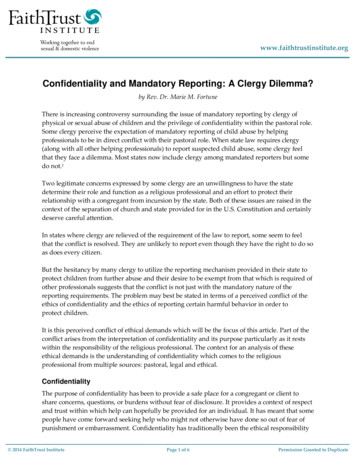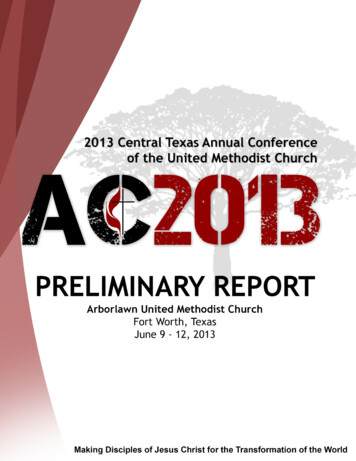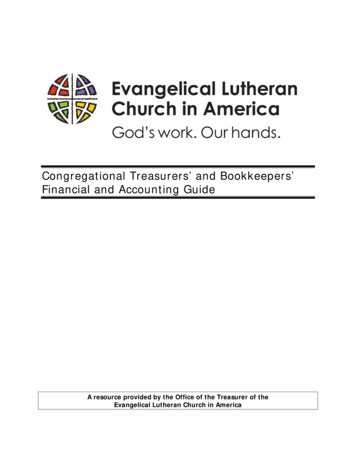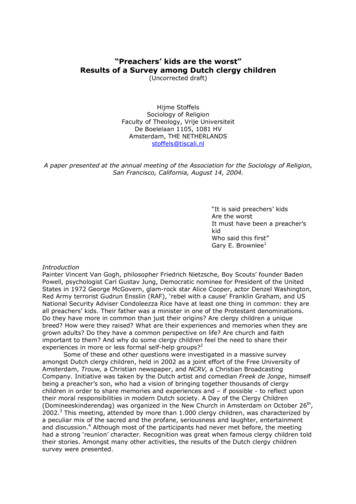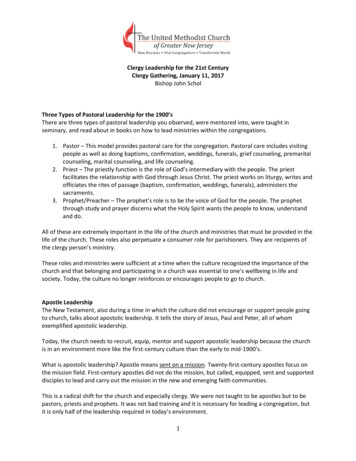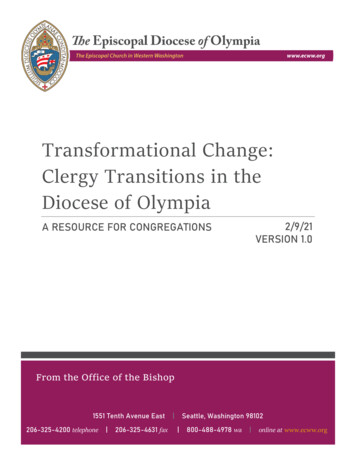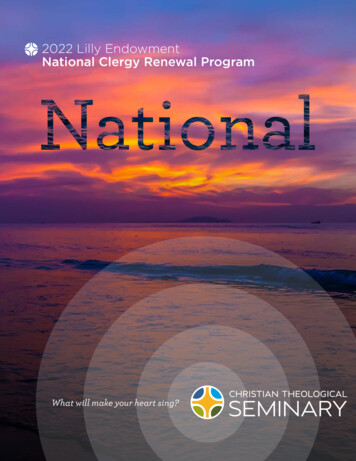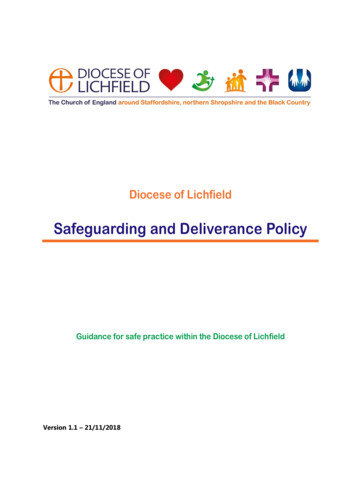
Transcription
A Guide to Clergy BenefitsRules in effect as of January 1, 2021Revised as of February 2021
Table of ContentsDear Friends: . . . . . . . . . . . . . . . . . . . . . . . . . . . . . . . . . . . . . . . . . . . . . . . . . . . . . . . . . . . . . . . . . . . . . . . . . . . . . . . . . 1About This Guide . . . . . . . . . . . . . . . . . . . . . . . . . . . . . . . . . . . . . . . . . . . . . . . . . . . . . . . . . . . . . . . . . . . . . . . . . . . . . . 2Clergy Pension Plan . . . . . . . . . . . . . . . . . . . . . . . . . . . . . . . . . . . . . . . . . . . . . . . . . . . . . . . . . . . . . . . . . . . . . . . . . . . 3About the Clergy Pension Plan . . . . . . . . . . . . . . . . . . . . . . . . . . . . . . . . . . . . . . . . . . . . . . . . . . . . . . . . . . . . . . . . . 3Clergy Pension Plan At-a-Glance . . . . . . . . . . . . . . . . . . . . . . . . . . . . . . . . . . . . . . . . . . . . . . . . . . . . . . . . . . . . . . . 4Participation and Eligibility . . . . . . . . . . . . . . . . . . . . . . . . . . . . . . . . . . . . . . . . . . . . . . . . . . . . . . . . . . . . . . . . . . . . . 6Cost of Coverage . . . . . . . . . . . . . . . . . . . . . . . . . . . . . . . . . . . . . . . . . . . . . . . . . . . . . . . . . . . . . . . . . . . . . . . . . . 10A Closer Look at Your Pension . . . . . . . . . . . . . . . . . . . . . . . . . . . . . . . . . . . . . . . . . . . . . . . . . . . . . . . . . . . . . . . . 11Pension Payment Options . . . . . . . . . . . . . . . . . . . . . . . . . . . . . . . . . . . . . . . . . . . . . . . . . . . . . . . . . . . . . . . . . . . . 16Requesting Your Pension Benefits . . . . . . . . . . . . . . . . . . . . . . . . . . . . . . . . . . . . . . . . . . . . . . . . . . . . . . . . . . . . . 19Working After Retirement . . . . . . . . . . . . . . . . . . . . . . . . . . . . . . . . . . . . . . . . . . . . . . . . . . . . . . . . . . . . . . . . . . . . 20Additional Benefits . . . . . . . . . . . . . . . . . . . . . . . . . . . . . . . . . . . . . . . . . . . . . . . . . . . . . . . . . . . . . . . . . . . . . . . . . . . 22Benefits If You Are Disabled Prior to Retirement . . . . . . . . . . . . . . . . . . . . . . . . . . . . . . . . . . . . . . . . . . . . . . . . . . . 22Post-Retirement Health Benefits . . . . . . . . . . . . . . . . . . . . . . . . . . . . . . . . . . . . . . . . . . . . . . . . . . . . . . . . . . . . . . . 26Other Post-Retirement Benefits . . . . . . . . . . . . . . . . . . . . . . . . . . . . . . . . . . . . . . . . . . . . . . . . . . . . . . . . . . . . . . . 27Benefits for Your Survivors . . . . . . . . . . . . . . . . . . . . . . . . . . . . . . . . . . . . . . . . . . . . . . . . . . . . . . . . . . . . . . . . . . . . . 29Life Event Changes . . . . . . . . . . . . . . . . . . . . . . . . . . . . . . . . . . . . . . . . . . . . . . . . . . . . . . . . . . . . . . . . . . . . . . . . . . . 33The Appeals Process . . . . . . . . . . . . . . . . . . . . . . . . . . . . . . . . . . . . . . . . . . . . . . . . . . . . . . . . . . . . . . . . . . . . . . . . . 35Glossary of Terms . . . . . . . . . . . . . . . . . . . . . . . . . . . . . . . . . . . . . . . . . . . . . . . . . . . . . . . . . . . . . . . . . . . . . . . . . . . . 38Contacts . . . . . . . . . . . . . . . . . . . . . . . . . . . . . . . . . . . . . . . . . . . . . . . . . . . . . . . . . . . . . . . . . . . . . . . . . . . . . . . . . . . . 43(866) 802-6333, Monday – Friday, 8:30AM – 8:00PM ET (excluding holidays) benefits@cpg.org cpg.org
Dear Friends:Whether retirement is a distant dream, a next step, or a pleasant reality,The Church Pension Fund (CPF) is here to help you achieve financial securitythroughout your ministry and in retirement.Reaching that goal requires both planning and partnership. We can help youplan. When we work actively together, CPF can be your informed and caringpartner because we know the complex ins and outs of your benefits package,and we have your best interests at heart.As this Guide makes clear, your participation in The Church Pension FundClergy Pension Plan (Clergy Pension Plan) offers you much more than apension benefit. It also ensures that you will have access to financial resourcesto help you and your family navigate different life events.During the 2015-2018 triennium, with input from more than 1,500 individuals,we undertook a comprehensive revision of the Clergy Pension Plan andrelated plans. The goal of our work was to adapt the plans to better suit theevolving needs of The Episcopal Church without reducing the overall value ofyour benefits. The feedback that we have received so far gives us confidencethat we have accomplished our goal.We hope you find this overview of the Clergy Pension Plan and related plansuseful. As questions arise, please contact us or visit our offices. You can reachus at (866) 802-6333, Monday – Friday, 8:30AM – 8:00PM ET (excludingholidays) or at benefits@cpg.org. We are here to help.Faithfully,Mary Kate WoldCEO and PresidentThe Church Pension Fund(866) 802-6333, Monday – Friday, 8:30AM – 8:00PM ET (excluding holidays) benefits@cpg.org cpg.org1
About This Guide The following Guide to Clergy Benefits (Guide) is designed to help youunderstand the provisions of The Church Pension Fund Clergy PensionPlan (Clergy Pension Plan) and other related benefit plans available as ofJanuary 1, 2021. Please keep in mind that this is intended to be a summarydocument only, and it should not be viewed as investment, tax, or otheradvice. To request a guide describing plan provisions in effect prior toJanuary 1, 2021, please contact our Client Services group. You will note that certain terms are capitalized throughout this Guide, whichmeans they are proper names or are defined in our Glossary of Terms.Other more commonly used terms, such as eligible spouse or eligible child,also appear in our Glossary of Terms because they have a very specificdefinition under the Clergy Pension Plan and/or other benefit plans. This Guide uses “you” and “your” when referencing an Episcopal clericwho is eligible to participate in the Clergy Pension Plan and the other relatedbenefit plans described throughout. This Guide describes the benefits available to eligible Episcopal clergy whowork their entire career in a domestic diocese of The Episcopal Church.Episcopal clergy who serve in both domestic and non-domestic diocesesshould contact our Client Services group for information about their benefitsas different rules apply. The official plan documents will govern the Clergy Pension Plan and allother related benefits provided by The Church Pension Fund (CPF). In theevent of a conflict between this Guide and the official plan documents,the terms of the official plan documents will apply. Please be advised thatCPF’s benefit plans are church plans and are not subject to the EmployeeRetirement Income Security Act of 1974, as amended. Individual situations may differ from those described in this Guide. If youwould like to discuss your specific circumstances, please contact ourClient Services group. Note that information on the medical and dental coverages available toactive employees is not covered in this Guide. Please refer to www.cpg.organd the Plan Document Handbooks for that information.(866) 802-6333, Monday – Friday, 8:30AM – 8:00PM ET (excluding holidays) benefits@cpg.org cpg.org2
Clergy Pension PlanAbout the Clergy Pension PlanThe Clergy Pension Plan is provided to eligible Episcopal clergy serving ina domestic diocese of The Episcopal Church; their eligible surviving spousesor other named beneficiaries; and their eligible children. The plan is designedto offer a dependable source of income replacement in retirement.This is a defined benefit pension plan, which provides a benefit basedon a predefined formula that takes into account your years of servicewith The Episcopal Church and compensation history. Benefits arefunded by employer contributions called Assessments (although thereare certain limited circumstances when you may contribute yourself).If you participate in the Clergy Pension Plan, you, your eligible spouse,eligible children, or other eligible designated beneficiaries may alsoreceive benefits provided by CPF under the following related plans: Post-Retirement Medical Assistance Plan (Medicare Subsidy Plan) Short-Term Disability Plan Long-Term Disability Plan Life Insurance Plan Child Benefit PlanEpiscopal clergy serving in a non-domestic diocese of the Churchparticipate in a different pension plan called the International ClergyPension Plan.If you are a cleric serving in the Diocese of Puerto Rico, you participate in theInternational Clergy Pension Plan for tax reasons. However, the benefits thatyou receive are identical to the benefits described in this Guide, and you canuse this Guide as your reference.Sources of Retirement IncomeYour pension can help you build asecure future. When planning forretirement, it is important that youlook at all of the sources that maybe available to you, including these: Social Security Personal resources, suchas individual savings andinvestments Other retirement benefitsyou or your spouse may haveearned in other professions Income you receive if youchoose to continue workingin accordance with the ClergyPension Plan’s Working WhilePensioned rulesNeed Help Planning?To find out how we can helpyou take control of your financialfuture, please contact our financialeducation specialists.If you are a cleric serving in another non-domestic diocese of The EpiscopalChurch, or if you have service in both domestic and non-domestic dioceses,please contact our Client Services group for details about your benefits.(866) 802-6333, Monday – Friday, 8:30AM – 8:00PM ET (excluding holidays) benefits@cpg.org cpg.org3
Clergy Pension Plan At-a-GlanceCPF is pleased to offer a comprehensive pension plan for eligible clergy of The Episcopal Church. This Guide offershighlights of the Clergy Pension Plan and related benefit plans. It provides details about the Clergy Pension Plan andother related benefits provided by CPF to eligible clergy and their families.ParticipationIf you are an ordained Episcopal cleric, you automatically participate in the Clergy Pension Plan if you are compensated,regularly employed, expected to work five or more consecutive months for the same Episcopal employer, and youremployer pays Assessments to CPF. If your position is expected to last for less than five months, and you have a letter ofagreement directing the payment of Assessments by your employer for the services that you will provide, you have theoption to participate in the Clergy Pension Plan.Learn more about when participation begins and eligibility for benefits here.How Benefits Are CalculatedYour pension benefits are calculated using a formula that takes into account various factors, including:What is it?Why is it important?The period of years and monthsthat your employer has paidfull Assessments on your TotalAssessable Compensation and,if applicable, for which you havepersonally paid Assessments.Credited Service is used tocalculate your pension amount.Highest Average CompensationIf you earn Credited Service onor after January 1, 2018, yourHighest Average Compensation isgenerally the average of the sevenhighest-paid, non-overlapping,12-month periods during whichyou earned Credited Serviceover your entire career.Highest AverageCompensation is used tocalculate your pension amount.Total Assessable CompensationThe basis for the amount youremployer pays in Assessments.Specifically, your employer mustpay 18% of your Total AssessableCompensation, which is the sum ofthe following annualized amounts:*Both Highest Average Compensationand Credited Service are dependenton your Total AssessableCompensation. For each monththat your employer pays the fullAssessment due, you will earnone month of Credited Servicetoward your pension, and your TotalAssessable Compensation for thatmonth may be counted toward yourHighest Average Compensation.(Credited Service toward theMedicare Supplement Health PlanSubsidy also may be earned.)Credited Service base salary (excluding housing)and scheduled taxable cashpayments, plus cash housing allowance and/orutilities, plus employer contributions to aqualified and/or non-qualifiedplan, plus one-time payments (appliesto month when paid), plus* Any form of severance (including pay continuation following a termination of employment) should be excluded in all cases. In addition, employer-paid tuition for dependents isnot assessable unless it is taxable, and imputed income is not assessable.(866) 802-6333, Monday – Friday, 8:30AM – 8:00PM ET (excluding holidays) benefits@cpg.org cpg.org4
What is it?Total Assessable Compensation(continued)Why is it important? t he value of employer-providedhousing, which equals 30%of the sum of the four bulletsabove. (However, if the sum ofthe four bullets above is lessthan the Hypothetical MinimumCompensation, the value ofemployer-provided housing equals30% of the Hypothetical MinimumCompensation.)Note that if the only type ofcompensation that your employerprovides is housing, then your TotalAssessable Compensation equals30% of the Hypothetical MinimumCompensation.Please note: Your Total Assessable Compensation is taken into consideration when determining your Highest AverageCompensation only if and when Assessments are paid in full. If you personally pay for Assessments, the compensation level on which you pay personal Assessmentsin full also will be taken into consideration when determining your Highest Average Compensation. CPF reserves the right to request documentation, such as a Form W-2 or a letter of agreement, at any timeto support the amount of an individual’s Total Assessable Compensation that is reported to us.VestingVesting means you are entitled to receive a pension benefit from the Clergy Pension Plan upon your retirement.You become vested when you earn five years of Credited Service or are age 65 or older while an Active participant.(For example, if you find your first employment in the Church when you are age 67, you will be fully vested under theClergy Pension Plan after your employer makes the first Assessment payment on your behalf.)If you participated in The Episcopal Church Lay Employees’ Retirement Plan or the Staff Retirement Plan of The ChurchPension Fund and Affiliates, your vesting service under those plans will count for vesting purposes under the ClergyPension Plan. You must provide a written request to CPF, along with any required supporting documentation, in orderto receive vesting credit.When You Can Begin Receiving BenefitsYou can begin receiving your vested pension benefit at the following point in time:Early RetirementAt or after age 55Normal RetirementAt or after age 65Mandatory ChurchRetirement AgeAt age 72** If you turned age 70½ prior to January 1, 2020, you may have been required to start receiving your pension by no later than April 1 of the year following the year in which youturned age 70½ (or, if later, by April 1 of the year following the year in which you stopped working in the Church).(866) 802-6333, Monday – Friday, 8:30AM – 8:00PM ET (excluding holidays) benefits@cpg.org cpg.org5
Participation and EligibilityTypes of ParticipationThere are two types of participation in the Clergy Pension Plan: mandatory and optional.Mandatory ParticipationIf (1) you are a deacon, priest, or bishop who is canonically resident inany diocese of The Episcopal Church, (2) your employer is subject to theauthority of the Church (or is associated with the Church and has electedto participate in the Clergy Pension Plan), and (3) your employer is locatedin a domestic diocese of the Church, you must participate in the ClergyPension Plan if you are expected to be regularly employed (as explained below) for five or moreconsecutive months by the same employer, and compensated* by your employer.You will be treated as regularly employed if you meet one of the followingrequirements: You have a letter of agreement (or other contract of employment) withyour employer You are duly called to your position by your bishop, vestry, or rector Your position has a formal title (for example, rector or priest-in-charge)indicating an ongoing substantial relationship with your employer Your employer issues you a Form W-2 (or equivalent) You are scheduled to work at least 20 hours per weekPlease note: If you are expected to be regularly employed for less thanfive consecutive months, but actually work for five or more consecutivemonths, your participation in the Clergy Pension Plan will be mandatoryretroactive to your date of hire. Please see When Enrollment Begins(and Ends) for additional details. Please report any changes to youremployment status to our Client Services group.Religious OrdersIf you are a member of a religious order,you cannot participate in the ClergyPension Plan unless and until your orderelects to participate and has all of itseligible clergy members enrolled in theClergy Pension Plan. In addition, yourorder must agree to pay Assessmentson behalf of all eligible clergymembers. Assessments are basedon each member’s Total AssessableCompensation. Please see Cost ofCoverage for details on Assessments.Two-clergy familiesIf both you and your spouse areordained, each of you will participate inthe Clergy Pension Plan independentlyand will receive benefits based on yourown service to the Church.Optional ParticipationThere are three types of optional participation:If You Are Expected toWork Less Than FiveConsecutive MonthsExtension of MinistryIf you would otherwise meet the criteria for mandatory participation exceptthat you are expected to be regularly employed for less than five consecutivemonths, you and your employer may choose to participate in the Clergy PensionPlan if you have a letter of agreement (or other contract of employment) thatprovides for the payment of Assessments on your behalf by your employer.If you are regularly employed by a non-Episcopal organization, or anysociety, organization, or body associated with The Episcopal Church thathas not elected to participate in the Clergy Pension Plan, you may chooseto participate in the Clergy Pension Plan through an Extension of Ministry.To qualify, you must be exercising active ordained ministry in pastoral,educational, or social work that will advance the mission of The EpiscopalChurch and that will not violate the Constitution and Canons. Please refer tothe Extension of Ministry application for more information. If CPF approvesyour Extension of Ministry application, it will be for up to two years. Foranother extension beyond the two years, you must submit a renewal requestto CPF (at the Client Services address listed in the back of this Guide).*Effective January 1, 2018, if your only compensation consists of ad hoc, one-time payment(s) -- that is, you have no regularly scheduled compensation -- enrollment inthe Clergy Pension Plan is not permitted.(866) 802-6333, Monday – Friday, 8:30AM – 8:00PM ET (excluding holidays) benefits@cpg.org cpg.org6
This request should be completed at least 60 days prior to the expiration ofthe approved period. There is no limit on the number of renewals that may begranted.Keep in mind that full Assessments must be paid on your Total AssessableCompensation to earn Credited Service under the Clergy Pension Plan foryour Extension of Ministry, and CPF maintains the right to request supportingdocumentation.Military ServiceCPF has special agreements with the Bishop Suffragan for Armed Forces andFederal Ministries covering Episcopal clergy who serve as full-time chaplains in the Armed Forces of the United States, theUnited States Department of Veterans Affairs, or the United States FederalBureau of Prisons, or serve as Reserve and National Guard members who are called to activemilitary duty and, as a consequence, must leave their employment in theChurch in order to serve. In certain cases, continued participation in theClergy Pension Plan is legally required.For details about these agreements, please contact our Client Services group.When Enrollment Begins (and Ends)Your enrollment in the Clergy Pension Plan will begin on the first day of the month coinciding with or immediatelyfollowing your date of hire once your employer makes the first Assessment payment on your behalf. For example,if your employment begins on March 15, 2018, your enrollment in the Clergy Pension Plan will begin on April 1, 2018,but only after your employer pays the full Assessment due for April.Your enrollment in the Clergy Pension Plan will end on the last day of the month in which your employment ends.For example, if your last day of work is October 15, 2020, your enrollment in the Clergy Pension Plan will end asof October 31, 2020, and your employer must pay the full Assessment due for October.Eligibility for BenefitsEligibility for the benefits described in this Guide is based on your participant status under the Clergy Pension Planas follows:You Will Be ActiveIf you are regularly employed and enrolled in the Clergy Pension Plan, haveearned at least one month of Credited Services, and Assessments are nomore than 24 months past due, or your enrollment in the Clergy Pension Plan has ended because you areno longer employed and no more than six calendar months have passedfollowing your last day of employment (referred to as a “six-month graceperiod”), or your six-month grace period is over, and you have paid personalAssessments for each month following your last day of employment up tothe current month, or you have earned 25 or more years of Credited Service, or you were classified as Deemed Active as of December 31, 2017. (In general,to be Deemed Active means that you were eligible to retire at the time youstopped earning Credited Service. As of January 1, 2018, Deemed Activeis no longer a status under the Clergy Pension Plan.) In addition, if you are approved for short- or long-term disability benefits,you will be considered Active under the Clergy Pension Plan as long as youare receiving disability benefits.(866) 802-6333, Monday – Friday, 8:30AM – 8:00PM ET (excluding holidays) benefits@cpg.org cpg.org7
You Will Be If Inactive your enrollment in the Clergy Pension Plan has ended because you areno longer employed, your six-month grace period (as described above)has ended, and you have not paid personal Assessments (or your personalAssessments are past due), or you are regularly employed and enrolled in the Clergy Pension Plan, butyour employer has not paid Assessments for more than 24 months, or you are not otherwise Active.Retired you have initiated retirement and started to receive your pension benefitsand have not subsequently returned to active ministry. (If you previously retired under the Clergy Pension Plan and then later returnto active ministry, your pension may be suspended unless you meet theWorking While Pensioned criteria or apply for an exception.)If You Are Deposed or RemovedNotwithstanding the rules above, if you are deposed or removed in accordance with the Constitution and Canons,you generally will be considered Inactive as of the first day of the month following your deposition or removal unlessyou have earned 25 or more years of Credited Service or were classified as Deemed Active as of December 31, 2017.The chart below shows the benefits you are eligible for based on your participant status under the Clergy Pension Plan.Please note that this is a high-level overview; other eligibility requirements and conditions apply. You will findsummaries of these benefits in this hort-TermDisability BenefitYesNoNoLong-TermDisability BenefitYesNoNoPreretirementSurvivor BenefitYes (benefit may bebased on CreditedService projectedto age 65)Yes, if vested (benefitis based on actualCredited Service)N/AResettlement BenefitUpon PreretirementDeathYesNoN/ALife Insurance BenefitYes(Pre- and Post-Retirement)NoYes, if Activeimmediately priorto retirementChild Benefit (Preand Post-Retirement)YesYes, if vestedYesPost-RetirementSurvivor BenefitN/AN/AYes, if electedat retirement(866) 802-6333, Monday – Friday, 8:30AM – 8:00PM ET (excluding holidays) benefits@cpg.org cpg.org8
RetirementBenefitActiveInactiveRetiredResettlement BenefitN/A (unless you receivelong-term disabilitybenefits for six months)N/AYes, if Activeimmediately prior toyour first retirement(and you have notalready received it)Monthly PensionN/AN/AYesChristmas BenefitN/AN/AYesDiscretionary Cost-ofLiving AdjustmentsN/AN/AYesPost-Retirement HealthSubsidy (that is, theMedicare SupplementHealth Plan Subsidy)N/AN/AYes, if Credited Servicerequirement is metIf You Have an Eligible SpouseYour eligible spouse may receive certain benefits described in thisGuide. An eligible spouse is an individual to whom you are legally married(1) both on the date you stop earning Credited Service and on yourretirement date or (2) on the date of your death, whichever occursfirst. In addition, you must earn at least 12 months of Credited Servicewhile married. Please note that unless all of these requirements aremet, your spouse will not be eligible for the spousal benefits describedin this Guide.Important note: Documentation is required. CPF requires a copyof your marriage certificate to determine eligibility for spousal benefits.If you cannot provide a marriage certificate, then your marriage mustbe evidenced by a written court order.What Happens if IMarry Later in life?If you are planning to retire shortlyafter you get married, or if youmarried after you had alreadystopped earning Credited Serviceunder the Clergy Pension Plan,your spouse may not be eligible forbenefits. We strongly recommendthat you carefully consider whetherto retire if you have not earned atleast 12 months of Credited Servicewhile married.If You Have an Eligible Child or ChildrenYour eligible child(ren) may receive certain benefits described in this Guide. Eligible children include these:A legal child who was living on the date that you stopped earning Credited Service or was born or adopted within12 months thereafter, orA stepchild, foster child, or legal ward who was your tax dependent both in the calendar year in which you stoppedearning Credited Service (or in the calendar year immediately following the year in which you stopped earning CreditedService) and in the calendar year of your deathIn addition, an eligible child must be under the age of 25 at the time of your death or must be disabled.If disabled, the eligible child must have become disabled prior to reaching the age of 25. (CPF will considera child to be disabled if he or she is receiving Social Security disability benefits or has been determinedto be disabled by CPF’s Medical Board, designated as Aflac Incorporated (Aflac), formerly known as Zurich AmericanLife Insurance Company.)(866) 802-6333, Monday – Friday, 8:30AM – 8:00PM ET (excluding holidays) benefits@cpg.org cpg.org9
Cost of CoverageEmployer AssessmentsYour employer funds the Clergy Pension Plan and all other relatedbenefits provided by CPF through Assessments. However, there arecertain situations when you may personally pay Assessments.The CPF Board of Trustees sets the Assessment rate, which is18% of your Total Assessable Compensation. This means thatevery month, your employer is required to pay 18% of 1/12 of yourprojected annual Total Assessable Compensation. If you havemultiple employers, each one is billed based on the portion of yourTotal Assessable Compensation that it pays or provides to you.InterestAll Assessments are due on the last day of the month for which they arebilled. If your employer does not pay the full Assessment when it is due,interest will be applied as follows: Prior to January 1, 2019, interest was charged on Assessments thatwere overdue by more than two calendar years. The annual rate usedto calculate interest was the Clergy Pension Plan’s discount rate, which– as of April 1, 2018 – was 3.875%. Beginning on January 1, 2019, interest will be charged on Assessmentsthat are three months or more overdue. The annual rate used tocalculate interest increased to 4%. The rate is subject to periodic review.Please note that CPF will not accept late Assessment payments unlessthe accrued interest is also paid. Once you retire under the ClergyPension Plan, no Assessments will be accepted other than in theordinary course of your retirement processing.A Word About Fundi
Credited Service is used to calculate your pension amount . Highest Average Compensation If you earn Credited Service on or after January 1, 2018, your Highest Average Compensation is generally the average of the seven highest-paid, non-overlapping, 12-month periods during which you earned Credited Service over your entire career .

